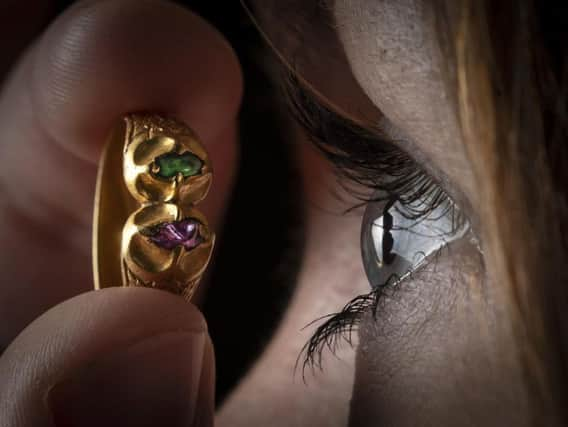Medieval ring that was amateur metal detectorist's 'find of a lifetime' goes on display in York


Paul Ibbotson, from Lancashire, originally found the 15th-century treasure in a farmer's potato field in the village of Fulford in December 2016.
The 50-year-old had spent 36 years searching the area with his metal detector before making the 'find of a lifetime'.
Advertisement
Hide AdAdvertisement
Hide AdIron Age shield found in Pocklington is 'one of the most important archaeological finds this millennium'The jewel is engraved with flowers and set with ruby and emerald gemstones, and was discovered just six inches beneath the surface of the soil.
He told the York Press back in 2017 that he fell to the ground in shock when he realised what it was.
The gold ring was in such good condition that it didn't even need to be cleaned.
An inquest was held in August 2017 and the object was officially declared treasure, meaning it is considered Crown property. In such cases an item is often offered for purchase by museums for display and research, and the York Museums Trust expressed interest in it.
Advertisement
Hide AdAdvertisement
Hide AdThey have now taken possession of the 'Fulford ring' and it is on public display at the Yorkshire Museum in York.
York Museums Trust assistant curator Adam Parker said the ring had been valued at £20,000 and was 'very special'.
"It was found on private land, but as it is more than 300 years old and its gold weight is more than 10 per cent it was classed as national property. It's an incentive to get people to report these finds.
"It is beautiful, and very finely decorated. The two gemstones, ruby and emerald, have 15th-century associations with chastity and love, so we think this was a betrothal ring given by a man to a woman as a love token."
Advertisement
Hide AdAdvertisement
Hide AdThe gemstones would not have been mined in Britain at the time, and experts believe they were imported from India, the Middle East or north Africa - suggesting that the owner was a member of the aristocracy and could even have connections to royalty.
"There are some that were found elsewhere in other museums, but this is the only one found in York. It tells the story of a relationship between a 15th-century couple - we can follow their courtship through the lens of this object. The stones are rare and would have been really exotic at the time.
"There are plenty of imitations but this ring is the real deal, it's been tested and is bona fide. A farmer from Fulford or a local priest wouldn't have owned it. The woman could have been travelling to York, as Fulford was a main road at the time, Perhaps it was stolen, or lost, or even thrown away in a fit of rage after an argument! It is very difficult to say who could have owned it.
"York was the capital of the north at the time, a centre of learning and an economic hub. It's a really special object, unique - it's the star of our medieval exhibition, and available for research for posterity."
The site where the ring was found was investigated but no further archaeological work has taken place, The landowner and Paul Ibbotson both received compensation for the find.